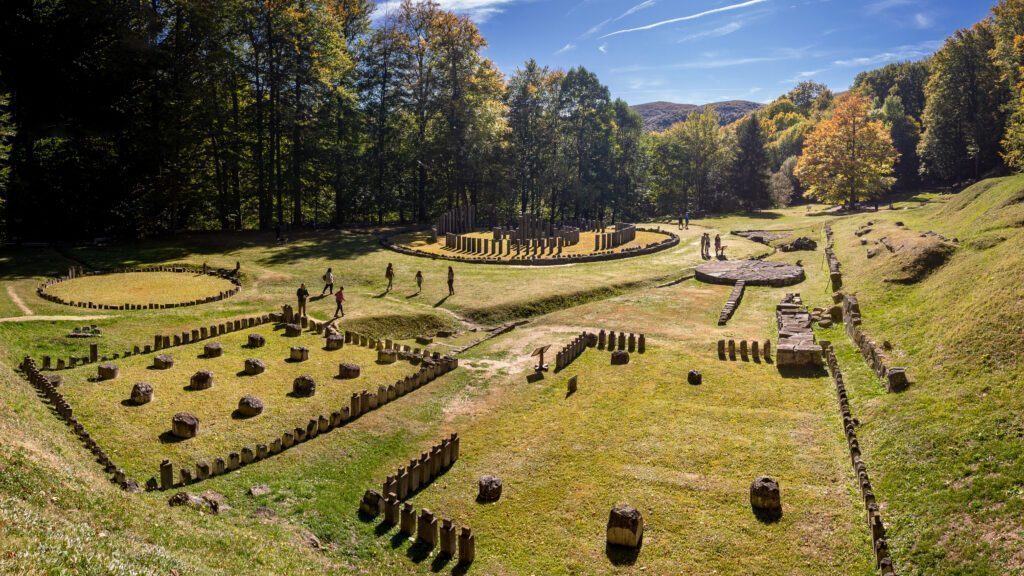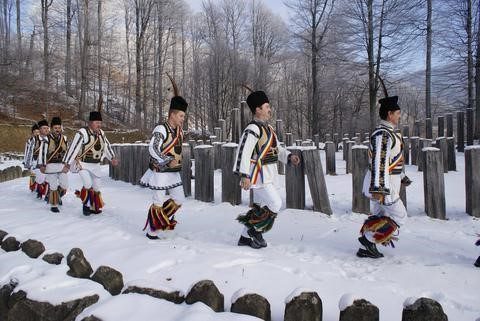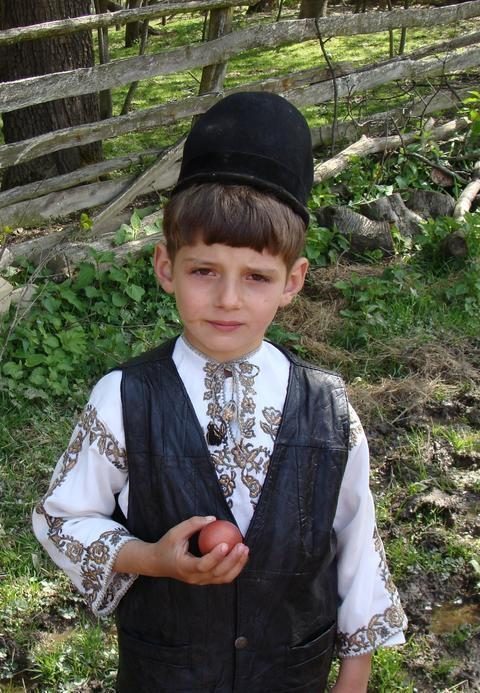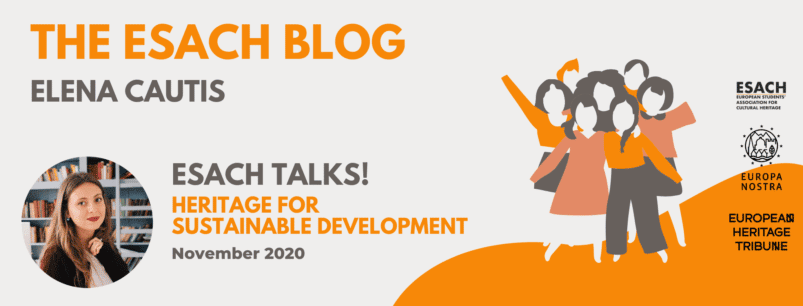The Capital of Dacia – A Living Museum of European Cultural Heritage, is an ongoing project aiming at the restoration, conservation and valorization of the UNESCO heritage site Sarmizegetusa Regia. At the inaugural conference held on 11 December 2020, Ștefan Bâlici, the manager of the National Institute of Heritage (NIH), underlined the uniqueness of such an initiative in post-communist Romania.
Written by: Elena Cautiș.
Its singularity stands because of both the magnitude of the actions designed for an efficient preservation of the site as well as the activities foreseen for an inclusive approach underpinning the valorization of the monument. As the site consists of archaeological remains situated in the Grădiștea Muncelului-Cioclovina natural park, surrounded by traditional communities, the preservation practices require a cross-disciplinary approach.
Therefore, various partners have been selected in this regard to ensure the development of strategies aimed at the sustainable preservation and valorization of the site which in return could contribute to long-term development in the general area. Given this context, even though the project’s premises advance from the heritage characteristics of the site, it becomes clear that in reality it has to deal with an entire cultural framework.

Previous preservation actions
Sarmizegetusa Regia is the former capital of the Dacian Kingdom and is part of a larger chain of defensive settlements situated in the Orăștiei Mountains, dating back to the period from the 1st century BC to the beginning of the 2nd century AD (Bârcă 2020). After the conversion of the kingdom into a roman province, in 106, the roman emperor ordered the demolition of these settlements and moved the capital to a newly erected city. Given the large presence of the remains and their historical background, the study of this archaeological site is crucial for understanding the Dacian civilization in the pre-roman era.
Inscribed in the World Heritage List (WHL) in 1999, along with five other Dacian fortresses as a single unit, Sarmizegetusa Regia did not receive adequate attention until 2012, when the County Council of Hunedoara became the legal administrator of the site (Bârcă 2020). Indeed, as indicated by the newly executives’ documentation approving interventions on the site, the first systematic archaeological excavations and restrained preservation actions were done in the 1980’s, but since then, Sarmizegetusa Regia has been quite neglected by the authorities (NIH 2018).
In fact, the issue of the abandonment of the Dacian fortresses inscribed in the WHL is a well-known case of poor heritage management and it is an intensely discussed matter among specialists in the field of cultural heritage in Romania (Bârcă 2020). Moreover, among these six different archaeological sites, only Sarmizegetusa Regia has a legal administrator.
Since 2012, there has been an increase of the activities in the area which, in 2017, culminated with an agreement between the County Council of Hunedoara and the NIH to invest in the creation of a long-term plan for its valorization (NIH 2018). Accordingly, the NIH elaborated a series of technical and historical studies in 2018, which further led to the launch of “The Capital of Dacia – A Living Museum of European Cultural Heritage”.

The natural and cultural environment add value to the cultural preservation strategies of the heritage site
Along with the historical context, the surrounding landscape is of a great cultural and natural richness. Sarmizegetusa Regia is situated in the Grădiștea Muncelului-Cioclovina natural park, which with its geological and biodiversity specificity is home to rural communities who value traditions dating centuries back. Among these communities, indeed another heritage element recognized by the UNESCO framework is the dance of Căluș Ritual, inscribed on the Representative List on Intangible Cultural Heritage in 2008 (UNESCO). This tradition represents an ancient purification and fertility rite, still performed in Romania and in some other areas of the Balkan Peninsula.

Moreover, the main occupation of the communities surrounding the site is agriculture, in harmony with the natural environment (Parcul Natural Grădiștea Muncelului-Cioclovina). In spite of their cultural richness, locals struggle to become self-sufficient and therefore, as it happens in many other rural areas in the country, young people choose to leave their villages and move to major urban settlements. In this view, the inclusive valorization of Sarmizegetusa Regia could limit their departure, by creating workplaces related to their cultural assets that, besides the archaeological vestiges, contribute significantly to the particularity of the place. It is therefore all the more important to conceive the valorization of the area as a process embedded in an entire cultural landscape.
Strategies for empowering the locals into building their own development system: Imagined activities
Mihai Eminescu Trust (MET) is the leading partner which took the responsibility for creating activities aiming at empowering the locals.This NGO, born in the early 2000’s, is a Romanian pioneer in creating strategies of sustainable development concerning vulnerable rural communities. Its activity is mainly based in the Saxon villages in Transylvania, which are known for their rich built heritage. It is primarily with the locals’ help that they have succeeded until now to safeguard this cultural legacy, which in exchange led to the recognition of these communities as its guardians. This approach has notably increased agricultural activities and the entrepreneurial initiatives related to sustainable cultural tourism, while leading to the development of an informal educational network (MET).
A similar model has been applied to the specific case of Sarmizegetusa Regia. Concretely, in the first stages of the elaboration of the project, MET imagined activities which could foster the same variety of development concerning the communities surrounding this site and which targeted especially young people. Here are some examples of the imagined activities:
- archeological summer camps, to facilitate the understanding of the importance of the site and transform it into an expression of local pride, as to create social cohesion;
- courses of cultural tourism guiding, to create jobs and allow the locals to become the bearers of the local history;
- handicraft workshops related to the site’s historically recognized commercial activities, such as blacksmithing;
- educational events for children and so on.
Having laid down the procedural premises of the project, the current pandemic crisis eventually hit its concretization. In fact, the foundation representatives’ interaction with the communities aiming to identify the main stakeholders and develop new activities was halted. Nevertheless, their statement is that such consultancies and the building of a long-term dialogue with the locals have to be considered crucial when targeting long-term benefits and so the establishment of such a dialogue has not been set aside, planning instead for its fulfilment when the regulations will allow. This is all the more important as the foundation’s activity is not based in the area. Thus, at the official ending of the project, the overriding goal is to have had already established a pattern of activities that can be proved sustainable, in order to both ensure long-term preservation of the heritage as well as to help the locals grow through this heritage.
The project as an opportunity of becoming a valuable example of sustainable management practice

As the project benefits from large visibility, the success of the targeted goals is all the more important, as it could set a path for future similar projects and become an example of sustainable preservation practice in the field of cultural heritage. This would on one hand ensure the long-term preservation of the site itself, and on the other hand it could motivate similar initiatives for the other still disregarded five Dacian fortresses. Moreover, it could lead to sustainable development in the area, encouraging the locals to get involved in the valorization process of the site, which could in exchange foster social cohesion. In doing so, this helps the locals to identify with the heritage site, as well as to realize the potential their own cultural identity bears in facilitating their development.
Despite the fact that the pandemic crisis has so far kept MET representatives from contacting the targeted communities in order to involve them in the decisional process, there is still time to initiate such a dialogue, as the official start of the project is planned for April 2021 and will last for a total of 48 months. The fact that the foundation underlined the necessity to build such a dialogue and that they are keeping the matter of the activities designed so far open to debate, proves not only the willingness to promote inclusive valorization practices, but also and especially their necessity when thinking of long-term sustainability concerning cultural heritage management initiatives.
About the author

Elena Cautiș studied History and Cultural Heritage Studies at the University of Bucharest and at the University of Perugia. Her main research interest is cultural heritage as a mean for achieving sustainable development. Currently, she is doing volunteer work at Mihai Eminescu Trust, helping with the research of inclusive valorization strategies for “The Capital of Dacia – A Living Museum of European Cultural Heritage”.
- E-mail: cautise@gmail.com
- LinkedIn: Elena Cautis
- Instagram: elenacautis12
- Facebook: Elena Cautis
References
- Bârcă, Valeriu. “Cetățile dacice din Munții Orăștiei după 20 de ani de la înscrierea lor în Lista patrimoniului mondial. Realizări, nerealizări, probleme actuale și perspective.” Managementul patrimoniului mondial: de la situația din România la exemple de bune practici, edited by Sergiu Musteață, Institutul de Arheologie, Iaşi, 2020, pp. 63-125.
- “Căluș ritual.” UNESCO, https://ich.unesco.org/en/RL/calus-ritual-00090. (Accessed 29 December 2020).
- “Comunități.” Regia Națională a Pădurilor-Romsilva. Parcul Natural Grădiștea Muncelului-Cioclovina, https://www.gradiste.ro/comunitati.html. (Accesed 29 December 2020).
- The Grant Application for the project “The Capital of Dacia – A Living Museum of European Cultural Heritage”, UAT County of Hunedoara, 2019.
- Proiect. Conservarea, restaurarea și punerea în valoare a sitului arheologic Sarmizegetusa Regia. Documentație de avizare a lucrărilor de intervenții. The National Institute of Heritage of Romania, 2018.
- “Projects.” Mihai Eminescu Trust, https://www.mihaieminescutrust.ro/en/projects/. (Accessed 29 December 2020).
- Studiu istorico-arhitectural de fundamentare a intervențiilor. Situl arheologic Sarmizegetusa punct „Dealu Grădiştii”. Jud. Hunedoara, Com. Orăştioara de Sus, Sat Grădiştea de Munte. The National Institute of Heritage of Romania, 2018.

